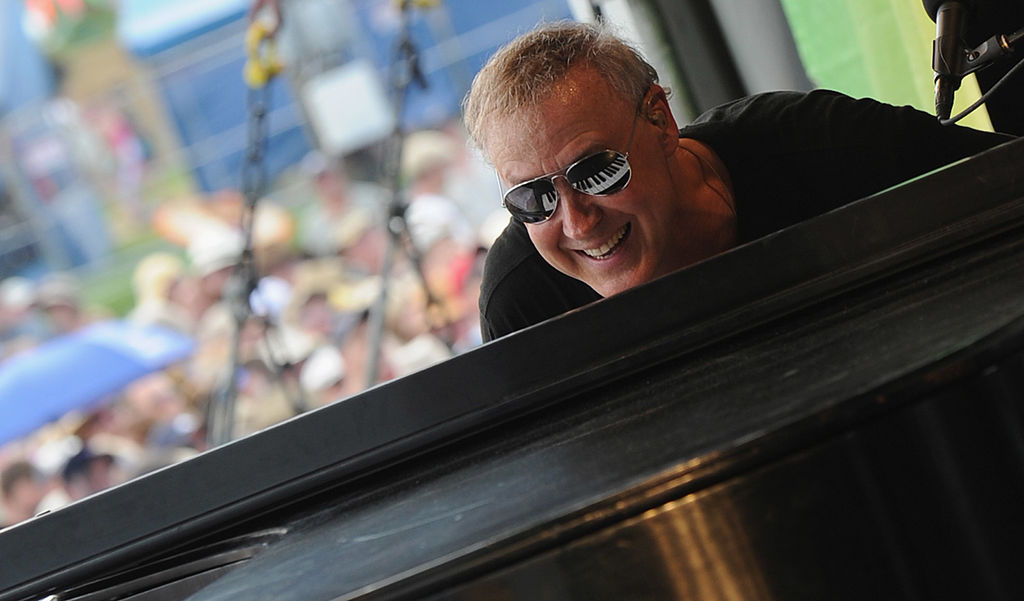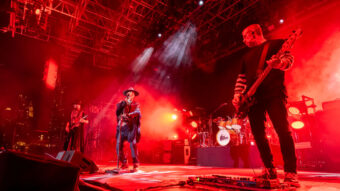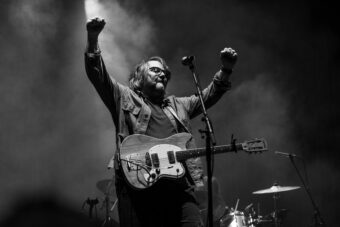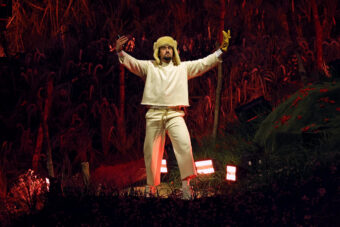If you think of Bruce Hornsby only as a mulleted late-‘80s smooth-rock lifer, making music somewhere off the coast of Sting’s solo career, then you haven’t been paying enough attention. A cursory sampling of the Virginia singer-songwriter’s new album Absolute Zero will evince how winding his journey has been since his 1986 breakthrough with the #1 hit “The Way It Is,” a song that’s remained ubiquitous enough over the years to give him an unjustified reputation as a one-hit wonder. From hyper-virtuosic jazz improvisations to traditional bluegrass to sample-heavy post-electronica, Hornsby’s long career is a lot stranger, more richly idiosyncratic, than that label would have you believe.
At times, Absolute Zero has a quality that recalls Hornsby’s formative work. “Cast-Off,” the album’s mournful lead single featuring Justin Vernon, reminds us how much of the Bon Iver songbook could be considered Hornsby fan fiction, and the Americana-tinged “Never in This House” could have reasonably been an outtake from Hornsby’s first album. But much of Absolute Zero is not “smooth” in the traditional sense. Hornsby’s intricate and impressionistic piano parts jut out at odd angles in the mix, the result of nearly 30 years of experimenting with 20th-century classical and avant-jazz styles—both playing them straightforwardly and incorporating borrowed elements into the pop song form.
https://open.spotify.com/embed/album/5Zks2SZNQAw4NYlUhVEE85
You get a taste of the more bewildering side of Hornsby’s genre-bending tendencies here, too. “Voyager One,” a song about the satellite of the same name and the sordid future of the human race, combines classical minimalism, bluegrass fiddle rhythms, and swing in a way that is either totally anti-musical or a stroke of mad genius. “Echolocation,” a bass-less oddity about a lost man on the other side of a DUI charge, combines lonesome country blues with John Cage prepared piano samples.
“How did we get here?”, fans of classic rock radio might reasonably ask, after listening to this ambitious, bizarre, sometimes beautiful album. Truthfully, it’s not hard to make sense of if you realign any conceptions you might have had about Hornsby being an anodyne AM-radio crooner. Instead, think of him as he truly deserves to be considered: a huge, brilliant weirdo. This doesn’t only extend to his discography, mind you. Hornsby has remained a curious presence in broader pop culture, and an enigma personally as well. (Did you know he could have been an NBA star?) The following primer is designed to guide you through the strangest aspects of the Hornsby mythos, from well-known tidbits to largely forgotten artifacts.
His fame grew as the result of a Tupac song.
One of the best-known aspects of Bruce Hornsby’s career is pretty odd in itself. After the breakout success of his debut album The Way It Is-–which earned him a Best New Artist Grammy win in 1987—Hornsby’s cultural ubiquity was solidified for a new generation of music fans in the ‘90s, thanks to a sample in “Changes,” a mournful hit by the West Coast’s most notorious gangsta rapper. And it wasn’t just Tupac who used “The Way It Is,” Hornsby’s sole No. 1 single, for hip-hop source material. E-40 interpolated the track on 1996’s “Things’ll Never Change” and Mase would go on to use it on his 1999 Double Up cut “Same N*ggas.” Also check out MC Buzz B’s “Never Change” and this 2008 Snoop Dogg and Charlie Wilson collab. Who doesn’t love some Hornsby?
And don’t count Hornsby among the aging rockers who object to rappers sampling their tunes. (Like Steely Dan). Hornsby never met Tupac, but he claims to be a fan. In a 2011 interview, he said: “I was sort of floored by his creativity. I thought he was so clever, and really profound, and deep. There’s a lot of gravitas to Tupac’s music, to me.” He wasn’t even bothered that ‘pac shifted the central lyrics to the opposite of what Hornsby originally wrote. (“Things will never be the same” vs. “Some things will never change.”) “Yeah, well, that’s right, but I thought it was a positive message, I didn’t think it was a negative message,” he said. “And I must say I like the checks.”
Not only does Hornsby like “Hit ‘Em Up” (see the interview linked above), he has even tried his hand at rap-adjacent vocals himself. Check out, for example, the semi-intoned patter on the second side of his 1998 album Spirit Trail— somewhat redolent of the Barenaked Ladies—if you don’t believe me.—WINSTON COOK-WILSON
He played in the Grateful Dead.
Hornsby has always been a jammer: even “The Way It Is” features not one but two positively rippin’ piano solos. Still, non-devotees may be surprised that the smooth-pop don had a stint playing keys (and occasional accordion) in the Grateful Dead. Hornsby began sitting in with the long-running group in the late ‘80s, and came on as something like a full-time member in 1990, after the death of previous keyboardist Brent Mydland. The early ‘90s were not exactly the Dead’s artistic heyday, but Hornsby had his moments, sprinkling graceful melodic lines into the crevasses of the band’s jams, his spacious approach to the piano nicely complementing their richly polyphonic sound. Sometimes, they even let him do a little singing. (In addition to being an underrated player, he was a more traditionally powerful vocalist than either Jerry Garcia or Bob Weir.) You can hear him belt out a few lines in the middle of this rousing version of “Jack Straw” from 1991.
Hornsby was out by ‘92, choosing to focus on his music rather than commit to the Dead’s relentless road schedule, but the brief period evidently made an impact on him. He’s returned to the Dead songbook often since then, and sometimes to the band itself, playing with various post-Jerry projects, including the celebrated Fare Thee Well shows in 2015, the last time the band’s core surviving members all shared the same stage. He’s also worked plenty of Dead-ness into his own bizarro polyglot late-career music, both in a general jammy sensibility and in specific references to their catalog. The most jarring example of the latter category is surely “Sunflower Cat (Same Dour Cat) (Down With That),” a 1998 song that’s as patently insane as its title, setting Hornsby’s lite-FM melodies over vaguely hip-hop drums and what sounds like a sampled audience recording of the Dead classic “China Cat Sunflower.”—ANDY CUSH
https://youtube.com/watch?v=2S7ZvaWLsmA
He won the Grammy for Best Bluegrass Recording in 1990.
From the very first notes of Hornsby’s debut album, the influence of bluegrass and American traditional music on his compositions was clear. The Hornsby fan must learn to love or choose to selectively ignore the proliferation of athletic mandolin strums and fiddle licks throughout his catalogue. Bruce’s true ‘grass transformation would come when he partnered with country hitmaker and world-class mandolin ripper Ricky Skaggs for an album in 2007. (More on that later.) But Hornsby was recognized as a champion of the style much earlier in his career. In 1990, he won a Grammy for Best Bluegrass Recording for a rollicking, banjo-driven reworking of his 1988 song “The Valley Road,” recorded with (why not?) the Nitty Gritty Dirt Band, on an album of country music duets.—WCW
https://youtube.com/watch?v=YRY0LSAaldc
He played at Woodstock ‘99.
Woodstock ‘99 was a disaster in so many ways: Robby Krieger doing Doors songs with Creed, Limp Bizkit fans setting porta potties on fire, The String Cheese Incident, and rampant violence and abuse. It’s no wonder people tend to forget one of the weekend’s most anomalous details: a performance by Bruce Hornsby. But if you still own the best-selling live album from the festival, you can find the proof there: Hornsby, the hardest working man in show business, bringing up the rear on Disc 2 with a live version of his “Resting Place.” At this storied nu-metal world’s fair, it’s safe to say that Bruce was the only savage on the lineup busting out Keith-Jarrett-inspired piano solos. Was any band there having as much fun that weekend as Hornsby’s sprawling septet, ripping disgustingly proficient gospel-blues licks all over a 8-minute rendition of “The Way It Is”? It’s hard to imagine who. Sevendust?—WCW
He’s written roughly over 200 pieces of music for Spike Lee movies.
A fair amount of it must have gone unused, but as Hornsby noted in a new Stereogum session this week, he’s written a boatload of music for his friend Spike Lee’s films since they struck up a friendship in the early 1990s. Most people associate trumpeter Terence Blanchard with the sound of Lee’s movies, but Hornsby is one of Lee’s most crucial musical confidants. Full Hornsby scores can be heard in 2009’s Kobe Doin’ Work, 2011’s If God Is Willing and da Creek Don’t Rise, 2012’s Red Hook Summer, and 2014’s Da Sweet Blood of Jesus. He also contributed music to 1995’s Clockers (a Grammy-nominated Chaka Khan duet!), 2000’s Bamboozled, and Lee’s 2013 Old Boy remake. And yes, folks: my dawgie Bruce turned in some tunes for the Spike-assisted video game NBA 2k16, too.—WCW
He’s a bit of a prankster.
Hornsby has a puckish streak, both musically and personally. If you were to conduct a simple Google search for his time in the Grateful Dead—let’s say, hypothetically, that you were doing research for a listicle about him—you would find that not one but two links on the first page of results are about various hijinx he pulled on his bandmates. Once, he says, he hired two bodyguard-sized guys to take the stage during “the most sensitive Weir ballad—I believe it was ‘Looks Like Rain’—to stand on either side of him, very closely, glowering at him as he sang.” And another time, Hornsby called Jerry Garcia, pretending to be a radio DJ that the two of them liked, and told the guitarist he was live on the air. He and Garcia apparently had a mutual appreciation for the art of the crank call. In this interview with Diablo magazine, Hornby says that Jerry turned him on to the Jerky Boys, ‘90s prankster dirtbags par excellence. Imagine Jerry late in his life, sitting in his room alone and cracking up to “You Kicked My Dog”—a weirdly poignant image, and one we wouldn’t have without Bruce.—AC
He plays insane medleys in concert.
In 2000, Bruce Hornsby released his first live album, a double-disc outing with his 2000s band The Noisemakers. Here Come the Noisemakers captured the band’s adventurous spirit, and stands as the definitive document of Hornsby’s jammy approach to live performance, which usually involves covers and offbeat musical humor incorporated into medleys with his own compositions. At one point on the album, he introduces “The Way It Is” with a long piano solo that incorporates George Gershwin’s 1935 Porgy and Bess standard “I Loves You Porgy,” and a piece by 20th-century composer Samuel Barber; later, he deploys a Bill Evans tune referencing 12-tone atonal music as a bridge into Spirit Trail’s working-class complaint “King of the Hill.” On the Noisemakers’ 2011 follow-up live album, Big Bruce riffs on avant-garde classical works by Charles Ives, Anton Webern, and Elliott Carter—all in the interest of playing nothing but the hits, of course.
There are plenty of videos of Hornsby in concert that will give you a taste of his aggressive style of pastiche. When playing “The Way It Is” at solo gigs these days, he often sticks a Bach invention in the middle of the song. In this 2015 performance (circa 8:50) of his biggest hit, he plays the main piano theme in the style of 18th-century counterpoint, like a molly-addled Glenn Gould. If you could rip the keys like Bruce, you’d probably show off this much too.—WCW
He made an experimental album inspired by Kid A in 2002.
In 2016, Hornsby explained that he was a big fan of “Everything In Its Right Place” and “Pyramid Song,” two of Radiohead’s most musically adventurous keyboard-driven compositions. Hornsby cited “Everything in Its Right Place” as the creative stimulus for “Sticks and Stones,” the opener of his 2002 full-length Big Swing Face, a experimental and heavily electronic album that bewildered Hornsby fans when it came out. The Radiohead influence doesn’t stop with the opening track: The feel of the “rain down, rain down” section of “Paranoid Android” is adopted for “The Chill,” for instance (complete with a solo by Grateful-Dead-adjacent guitarist Steven Kimrock). The rest of Big Swing Face embraces vestiges of the IDM and drum-and-bass music that was influencing Thom Yorke and the boys at the time, and also incorporates some fairly aggressive trip-hop beats (“Try Anything Once”).—WCW
He recorded a bluegrass version of Rick James’ “Super Freak” with Ricky Skaggs.
The nadir of Bruce Hornsby’s career came roughly 12 years ago, when this deeply cursed recording was released to the public. The John Anderson credited on backing vocals here, mind you, is the Nashville country hitmaker of the same name, not Jon Anderson from Yes (though with a wild-ass career like Hornsby’s, that certainly wouldn’t be out of the realm of possibility).—WCW
He debuted an unheard Ornette Coleman composition on one of his albums.
One of the under-appreciated joys of Bruce’s Hornsby discography is his 2007 instrumental jazz studio outing, Camp Meeting. The line-up is a power trio, featuring virtuoso bassist Christian McBride and Jack DeJohnette, the renowned Miles Davis and Keith Jarrett sideman who ranks among the greatest jazz drummers ever. Hornsby got access to a tune that the legendary free-jazz pioneer Ornette Coleman never recorded, and debuted it as the opening track of Camp Meeting. It’s a big co-sign from a legend, and the recording, like the album, is unimpeachable proof of Hornsby’s myriad talent. A duo collaboration between Hornsby and Coleman, “Hop, Skip, & Jump,” was also released on a box set of unreleased recordings and rarities in 2006.—WCW
He plays a crucial role in the 2009 film World’s Greatest Dad, directed by Bobcat Goldthwait and starring Robin Williams.
World’s Greatest Dad is an anomaly of a film, a pitch-black comedy directed by Bobcat Goldthwait about a school teacher (Robin Williams) who forges a touching suicide note to save his deadbeat teenage son’s legacy after he dies during autoerotic asphyxiation. One of the strangest elements of the film is that, to his son’s extreme chagrin, Williams’ character is a Hornsby obsessive. The result is a ton of Hornsby jokes, a soundtrack that is roughly half Hornsby songs, and a performance by the man himself during a climactic scene.—WCW
He claims he beat Allen Iverson in one-on-one basketball after helping him get out of jail.
In a recent interview with Uproxx, Hornsby acknowledged that the idea of him beating Allen Iverson at one-on-one basketball “seems completely ludicrous” and “not believable.” He’s not wrong. But it’s true, at least according to Hornsby himself, the “lots of witnesses” he claims were there, and the 2001 AI biography Only the Strong Survive, by veteran journalist Larry Platt, not the sort of guy who’d make something like that up. But it’s also true that the future NBA legend was still in high school when it happened, and that they weren’t exactly playing by the standard rule book. According to this Only the Strong Survive excerpt, Hornsby (who played high school ball himself) insisted on what he called “Piano Hands Rules,” which were meant to protect his precious ivory-ticklers. Possession automatically switched every time the offensive player took a shot, whether or not they made it, eliminating the possibility of a fight over a rebound. “I had one of those days where I couldn’t miss,” Hornsby said, and that was that.
How did the middle-aged singer-songwriter come to square off against the teen phenom in the first place? Iverson was already a local star in his Virginia hometown even as a high schooler, and Hornsby, a fellow Virginian, was aware of his reputation. In 1993, the young athlete was jailed for an alleged fight, which the musician considered a “serious miscarriage of justice.” Hornsby used his stature to lobby governor Doug Wilder for Iverson’s release, and Wilder granted Iverson clemency after four months in jail. Hornsby got a call from Iverson’s coach not long after, telling him that Iverson wanted to meet him and thank him for his help. Bruce Hornsby: not just a great pianist, not just a great ballplayer, but a great guy, too.—AC
He’s the inspiration for one of Veep’s best jokes.
Veep’s Kent “Grey Elvis” Davison (Gary Cole) is a robotic, seasoned D.C. operative ruled almost exclusively by data and algorithms rather than feelings or instinct. Whether he’s getting stalked by dead-eyed careerist sharks at his pilates class or trying and failing to flirt with VP Selina Meyer’s (Julia Louis-Dreyfus) chief scheduler Sue Wilson (Sufe Bradshaw). Although Kent’s demeanor is eerily even keeled, the rare flash of anger surfaces when he confronts his perpetually slimy former colleague turned morning show host Dan Egan over an egregious error Dan supposedly made during a broadcast. “You said on-air that Bruce Hornsby was a member of the Grateful Dead,” Kent told Dan after snatching the phone out of Rep. Jonah Ryan’s (Timothy Simons) hand. “He was a touring member from ’90 to ’92. He never officially joined.”—MAGGIE SEROTA
Now, we’ll end this the only way we know how: with a video of Hornsby, B.B. King, Lou Reed, and legendary guitarist Jeff “Skunk” Baxter covering Bob Dylan’s “The Mighty Quinn” on Herbie Hancock’s ‘90s Showtime variety show—a cast of characters only Bruce could assemble.




